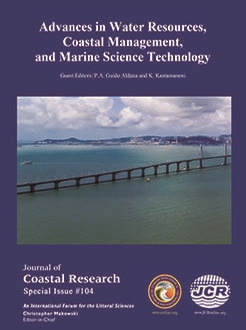Wang, H.Z., Zhong, H.P., Lu, J.Z., Yan, Q.Q., Li, S., and Zhou, Y., 2020. Understanding the river-lake relationship after the operation of TGR based on SWAT model. In: Guido Aldana, P.A. and Kantamaneni, K. (eds.), Advances in Water Resources, Coastal Management, and Marine Science Technology. Journal of Coastal Research, Special Issue No. 104, pp. 593–600. Coconut Creek (Florida), ISSN 0749-0208.
It is an important issue how the operation of Three Gorges Reservoir (TGR) has impacted upon the hydrological relationship between the Yangtze River and the Poyang Lake. A SWAT model was built to simulate the runoff of the River and the Lake, and the energy difference (Fe) index was selected to characterize the river-lake relationship. The results show: (1) The SWAT model was verified suitable to simulate the runoff of the study area. (2) The monthly trend of River-lake relationship after the operation of the TGR from 2010 to 2018 was studied. The successive monthly strong effect of the River (Fe<-0.1) appeared in August and September of 2010, which corresponded to the period of severe flood of the Lake basin. The successive monthly strong effect of the Lake (Fe>0.1) appeared in November and December of 2013, which corresponded to the period of severe draught of the Lake basin. (3) The yearly trend showed the constant increase of the role of the Lake and the constant decrease of effect of the Yangtze River main stream. (4) Under the operation of the TGR, the Yangtze River plays a stronger role during the drainage and flooding periods, leading to the increase of the flood control pressure in the Poyang Lake basin; the effect of the Poyang Lake is enhanced during the water storage and dry period, leading to the increase of the risk of drought disasters in the Poyang Lake basin. The study systematically reveals the change pattern of the river-lake relationship after the operation of the TGR at different time scales.





